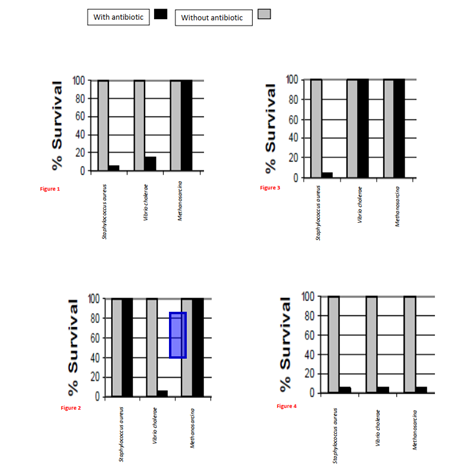You have recently been hired as a researcher in a premier university. Your research deals with isolating novel antibiotics from Streptomyces species to offer solution in the growing problem of antibiotic resistance. Unfortunately, late one night you did not label the tubes and plates clearly. Now your promising work needs to be resolved with only a few of information retained. Gladly, you found the results in your notebook. Unfortunately, they are not labeled either. These graphs represent percentage of survival of bacteria after treatment with the antibiotics. Samples with antibiotic added (black bars); controls with no antibiotic added (grey bars). You need to identify which antibiotic was used per set-up (see figure). Listed below are some essential information. Antibiotic A: 0.5 kDa protein, targets peptidoglycan Antibiotic B: 20 kDa protein, targets peptidoglycan Antibiotic C: Cationic antimicrobial peptide Antibiotic D: Targets lipopolysaccharide Staphylococcus aureus: gram-positive bacterium Vibrio cholera: gram-negative bacterium Methanosarcina: an archaean bacterium Cationic antimicrobial peptides (CAMPs): these positively charged antibiotics are attracted to the negatively charged cell wall and membrane. They are hydrophobic, and they insert into the membranes to create pores. You can describe the result in the graphs provided to help you explain your answer.
You have recently been hired as a researcher in a premier university. Your research deals with isolating novel antibiotics from Streptomyces species to offer solution in the growing problem of antibiotic resistance. Unfortunately, late one night you did not label the tubes and plates clearly. Now your promising work needs to be resolved with only a few of information retained. Gladly, you found the results in your notebook. Unfortunately, they are not labeled either. These graphs represent percentage of survival of bacteria after treatment with the antibiotics. Samples with antibiotic added (black bars); controls with no antibiotic added (grey bars).
You need to identify which antibiotic was used per set-up (see figure). Listed below are some essential information.
Antibiotic A: 0.5 kDa protein, targets peptidoglycan
Antibiotic B: 20 kDa protein, targets peptidoglycan
Antibiotic C: Cationic antimicrobial peptide
Antibiotic D: Targets lipopolysaccharide
Staphylococcus aureus: gram-positive bacterium
Vibrio cholera: gram-negative bacterium
Methanosarcina: an archaean bacterium
Cationic antimicrobial peptides (CAMPs): these positively charged antibiotics are attracted to the negatively charged cell wall and membrane. They are hydrophobic, and they insert into the membranes to create pores.
You can describe the result in the graphs provided to help you explain your answer.

Trending now
This is a popular solution!
Step by step
Solved in 2 steps


